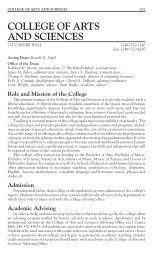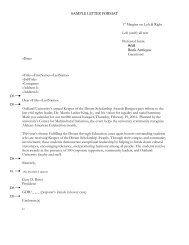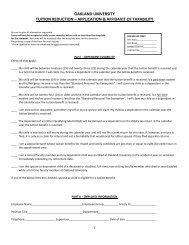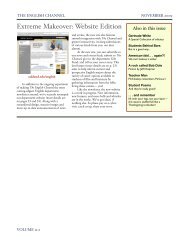MOM 2006 journal for pdf.pmd - University of Michigan-Flint
MOM 2006 journal for pdf.pmd - University of Michigan-Flint
MOM 2006 journal for pdf.pmd - University of Michigan-Flint
You also want an ePaper? Increase the reach of your titles
YUMPU automatically turns print PDFs into web optimized ePapers that Google loves.
Data Collection and Analysis<br />
Imara’s behaviors were analyzed using focal animal sampling, which is a fixed period <strong>of</strong><br />
continuous observation on a single individual or small group <strong>of</strong> individuals. Event behaviors,<br />
which are instantaneous or momentary, occur without measurable duration, and can be<br />
considered the onset <strong>of</strong> any behavior, were recorded into a field <strong>journal</strong>. The frequency <strong>of</strong> one<br />
behavior was divided by the total number <strong>of</strong> identified behaviors to yield the relative frequencies<br />
and the probability <strong>of</strong> a behavior occurring at a particular time (Paterson 2001).<br />
Results<br />
Imara was observed to have 36 defined behaviors (Figure 2). Locomotion had the highest<br />
relative frequency <strong>of</strong> 0.25. The second highest was rest recorded at 0.13. The relative frequency<br />
<strong>of</strong> groom self was 0.09 and receive embrace was 0.08. Scan had a relative frequency <strong>of</strong> 0.07.<br />
Groom and Chiana-present was recorded at 0.05 and 0.04 respectively. Forage, bark, receive hit,<br />
and stare all had a relative frequencies <strong>of</strong> 0.03. Being kissed, scream, bob, retreat, and play had<br />
relative frequencies <strong>of</strong> 0.02. The relative frequencies <strong>of</strong> give embrace and eat was 0.01. Leap,<br />
climb, copulation, and feed had relative frequencies <strong>of</strong> 0.006. Aggressive display and pace was<br />
recorded at 0.004. The relative frequencies <strong>of</strong> swing, being groomed, cling, and chase all were<br />
0.003. The lowest relative frequency <strong>of</strong> 0.001 was recorded in the behaviors Tanya-present,<br />
observe public, give kiss, bipedal locomotion, hang, and drink. Present and Peaceful had no<br />
relative frequency (Figure 2).<br />
Meeting <strong>of</strong> Minds <strong>2006</strong><br />
12
















